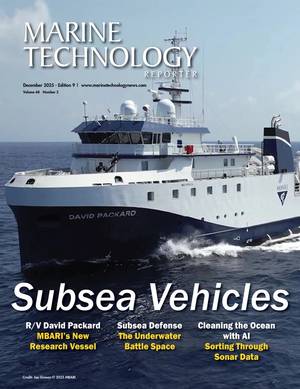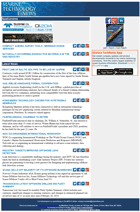
NUWC Division Newport Hosts Change of Command
USS Nevada (SSBN 733) Gold Crew and the USS Pennsylvania (SSBN 735) Blue Crew. In September 2017, Hennings became an acquisition professional and served with the Columbia-class Submarine Program Office (PMS 397), the Undersea Defensive Weapons Systems Program Office (PMS 415), and the Submarine Acoustic Systems Program Office (PMS 401).While Hennings will depart as commanding officer at Division Newport, he will continue to work at the warfare center as liaison with the Program Executive Office, Undersea Warfare Systems (PEO UWS), Team Submarine.“It’s truly been an honor to serve you, the

Lander Lab: Chilean Ocean Lander Data Acquisition and Control System
capable of collecting water samples at chosen depths, as well as downcast and upcast conductivity-temperature-depth plus dissolved-oxygen (CTD-O) profiles to hadal depths.Ocean landers currently see limitations related to their data acquisition and control (DAC) systems. Most are controlled using acoustic systems operated from a surface vessel or pre-set countdown timers. In many applications, commercial sensors are often unnecessarily operated at their maximum sampling rates throughout the entire mission, depleting critical battery power. Chilean marine researchers have derived a hybrid design

Kongsberg Discovery Launches HiPOS – HiPAP Positioning Software
in the most demanding environments.”HiPOS can be used across the latest generation of Kongsberg Discovery HiPAP systems, including the 602, 502, 352 and µPAP solutions.In addition to the software innovation, the Norwegian-headquartered business has also added two models of portable SSBL acoustic systems to its market-leading portfolio, the µPAP 201-C and HiPAP 352P-C. With computers built into the transceiver/transducer housing this offering allows for easy installation on smaller uncrewed vessels by negating the need for a separate onboard computer

Saildrone Unveils New Acoustic Capabilities to Protect Marine Mammals
species monitoring and mitigation compliance services, to create a monitoring network using cutting-edge acoustic technology, autonomous vehicles, and machine learning to detect, classify, and localize marine mammals.Two Saildrone uncrewed surface vehicles (USVs) equipped with proprietary underwater acoustic systems were deployed off the coast of Massachusetts to listen for North Atlantic right whales and other marine mammals. The virtually silent saildrones were stationed in an area where several species of whales are known to be present. During the two-week deployment, the saildrones recorded numerous

Sonardyne Deploys 'New Breed' of Subsea Sensors at Shell's Ormen Lange Field
;"Each sensor accurately collects pressure, temperature and inclination data at the seafloor, at pre-programmed intervals. The data is then periodically harvested, from an integrated high speed acoustic modem contained within each Fetch PMT or Fetch AZA PMT, using a choice of Sonardyne’s acoustic systems deployed from an unmanned surface vehicle (USV) or conventional ship. The data is then used to calculate any vertical displacement of the seabed at the Ormen Lange field," the company explained.Shaun Dunn, Vice President of Projects at Sonardyne, says, “Many years ago, geophysicists

Barcodes to Drive Down Pipeline Inspection Costs
sea trial on much smaller surfaces – down to pipes of 6” in diameter – in the South of France. The tests were a success, proving that these markers, combined with iXblue’s and Forssea’s expertise, can be used to provide accurate subsea positioning without the need for acoustic systems.&rdquo

VIDEO: Barcode Tags Could Cut Subsea Pipeline Inspection Costs
sea trial on much smaller surfaces – down to pipes of 6” in diameter – in the South of France. The tests were a success, proving that these markers, combined with iXblue’s and Forssea's expertise, can be used to provide accurate subsea positioning without the need of acoustic systems."

DOLPHIN: Enabling Technology for Acoustic Systems
DOLPHIN Signal Processing TechnologyAcoustics enable many core undersea capabilities. Where radio waves do not propagate well, and light is absorbed quickly, acoustic signals help us map, see, locate and communicate. The many products and technologies that employ acoustics all depend upon signal processing, thus new processing approaches can impact many applications. QinetiQ North America (QNA) and its partner Optimal Systems Laboratory (OSL) have developed DOLPHIN - a patented method using analog cancellation that eliminates receiver saturation and enables simultaneous transmit and receive.

Tech Talk: GeoSpectrum Acoustic Solutions
company GeoSpectrum Technologies Inc, a producer of underwater acoustic transducers and systems, has been in operation for more than 20 years, supplying hydrophones and sound projectors to a range of customers in the marine and oceanography sectors, as well as providing consultancy services on acoustic systems integration and test procedures. End-user sectors include defense and homeland security, oil & gas, and environmental services. As well as standard products, GeoSpectrum can also provide customized products and is particularly recognized as a leading provider of systems for the marine mammal
 December 2025
December 2025





